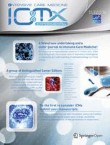Hydrocortisone decreases lethality and inflammatory cytokine and nitric oxide production in rats challenged with B. anthracis cell wall peptidoglycan
Lethal B. anthracis infection produces high proinflammatory peptidoglycan (PGN) burdens in hosts. We investigated whether the lethality and inflammation anthrax PGN can produce are related.
